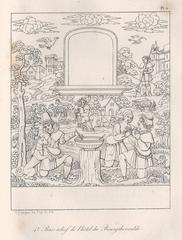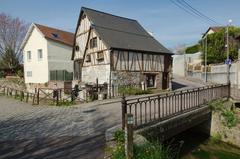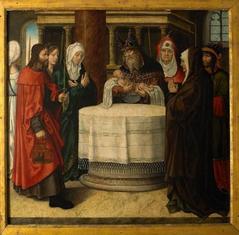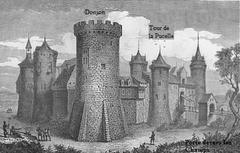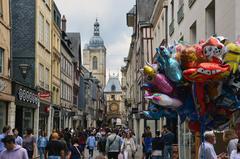Boulevard D’Orléans, Rouen, France: Visiting Hours, Tickets, and Historical Sites Guide
Date: 04/07/2025
Introduction
Boulevard D’Orléans in Rouen, France, is a distinguished urban boulevard that weaves together the city’s deep historical roots and its vibrant modern character. Developed during the 19th century as part of Rouen’s urban renewal, the boulevard remains a vital connector between the city’s medieval heart and contemporary districts. This guide offers a comprehensive overview of Boulevard D’Orléans, highlighting its historical significance, nearby attractions, practical visitor details, and travel recommendations for an enriching experience in Rouen.
For further details and visual references, consult these resources:
lifeinruralfrance.com,
about-france.com,
touristplaces.guide.
Historical Overview of Boulevard D’Orléans
Origins and Urban Development
Boulevard D’Orléans was laid out in the 19th century as part of Rouen’s modernization, influenced by the Haussmannian transformations in Paris. The objective was to improve traffic circulation, urban sanitation, and aesthetics, all while maintaining Rouen’s distinctive medieval street plan (about-france.com). As Rouen expanded from its Celtic origins and Roman foundation (then Rotomagus), the demand for broader, organized avenues grew—culminating in the development of thoroughfares like Boulevard D’Orléans. This strategic artery connects the historic core to newer districts, serving as both a symbol of progress and a testament to the city’s enduring heritage.
Architectural and Urban Significance
The boulevard showcases an elegant blend of Haussmannian facades, characterized by stone buildings, wrought-iron balconies, and tree-lined sidewalks. These features contrast with Rouen’s famed medieval half-timbered houses and Gothic landmarks nearby, illustrating the city’s architectural diversity (educba.com). The avenue’s modern layout enhances accessibility for both pedestrians and vehicles while linking significant neighborhoods and facilitating daily urban activity.
Integration with Rouen’s Heritage and Urban Life
Boulevard D’Orléans is a bustling corridor, home to shops, cafes serving Norman cuisine, and essential services. It is a popular route for both locals and tourists, offering direct access to iconic sites such as the Gros-Horloge, Rouen Cathedral, Place du Vieux-Marché, and the Musée des Beaux-Arts (touristplaces.guide). Its central location and proximity to transport hubs make it an ideal starting point for exploring Rouen’s layered history.
Urban Renewal and Preservation
Recent decades have seen renewed investment in Boulevard D’Orléans, with enhancements to pedestrian pathways, improved public transport, and preservation of architectural heritage. These efforts reflect Rouen’s commitment to balancing modern needs with the conservation of its historical character.
Practical Visitor Information
Visiting Hours & Tickets
- Boulevard D’Orléans: Open and accessible 24/7; no ticket required.
- Nearby Monuments: Museums and churches along or near the boulevard usually have specific hours and may charge admission. For example, the Musée des Beaux-Arts and certain cathedral exhibitions require tickets—check individual sites or Rouen Normandy Tourism for current details.
Accessibility
- Wide, well-maintained sidewalks and ramped crossings ensure wheelchair accessibility.
- Public buses and trams serving the boulevard are equipped for visitors with reduced mobility.
Travel Tips
- Best Visiting Times: Daytime for sightseeing and enjoying local commerce.
- Transport: The T5 bus line and other public transit routes offer easy access; parking is available but limited.
- Local Dining: Numerous cafes and bistros along the boulevard feature Norman specialties.
- Construction Notices: Occasional infrastructure projects may affect accessibility; check Metropole Rouen Normandie for updates.
Guided Tours and Special Events
- Boulevard D’Orléans is frequently included in themed walking tours focused on Rouen’s history and architecture.
- During city festivals and markets, the boulevard hosts cultural events and showcases local crafts.
- For self-guided experiences, consider using the Audiala app for audio tours and up-to-date event information.
Key Historical and Cultural Sites Near Boulevard D’Orléans
Gros-Horloge
A 14th-century astronomical clock, the Gros-Horloge is a quintessential symbol of Rouen.
- Hours: April–October, 10:00 AM–6:30 PM; November–March, 10:00 AM–5:30 PM. Closed Jan 1, May 1, Dec 25.
- Tickets: Adults €6, reduced €4, free for children under 18.
- Highlights: Climb the tower for panoramic city views, interactive exhibitions, and guided tours in English are available (rouentourisme.com).
Rouen Cathedral (Cathédrale Notre-Dame)
A masterpiece of Gothic architecture and a city landmark.
- Hours: Open daily 8:00 AM–6:30 PM; special event hours may apply.
- Tickets: General entry is free; some exhibitions and guided tours require tickets (€5–10).
- Accessibility: Ramps, lifts, and accessible restrooms; assistance available at the visitor center.
- Transport: Easily reached by bus, tram, and on foot from Boulevard D’Orléans (rouentourisme.com).
Place du Vieux-Marché
A historic square renowned as the site where Joan of Arc was executed. The square features a modern church and vibrant markets.
Musée des Beaux-Arts de Rouen
One of France’s leading fine arts museums, located a short walk from the boulevard.
- Collections: European paintings, including works by Monet and Géricault.
- Hours and tickets: Please verify on the official website for current information.
Additional Sites
- Mont-Riboudet Transport Hub: Gateway to historic neighborhoods.
- Parc d’Iberville: A serene park with historical significance, open year-round.
- Nearby Historic Churches: Explore Gothic and Renaissance ecclesiastical architecture within walking distance.
Visitor Experience and Highlights
Boulevard D’Orléans is ideal for leisurely walks, photography, and immersing yourself in Rouen’s urban landscape. Its strategic location places you steps away from celebrated monuments, parks, shops, and traditional markets. Regularly updated signage and tourist maps make self-guided exploration easy. During festivals, the boulevard is transformed into a lively cultural avenue.
Frequently Asked Questions (FAQ)
Q: What are the opening hours for Boulevard D’Orléans?
A: The boulevard is open to the public 24/7.
Q: Are tickets required to visit the boulevard?
A: No, but tickets may be needed for museums and attractions nearby.
Q: Is the boulevard accessible for visitors with reduced mobility?
A: Yes, with wide sidewalks, ramps, and accessible public transport.
Q: Are guided tours available?
A: Yes, both local tour operators and digital platforms like Audiala offer guided experiences.
Q: What’s the best time to visit?
A: Daytime hours, especially mornings and weekdays, are less crowded.
Q: Are there special events on the boulevard?
A: Markets and cultural events are held throughout the year; check the city’s event calendar.
Final Recommendations and Summary
Boulevard D’Orléans is a microcosm of Rouen’s historical legacy and dynamic city life. Its elegant architecture, accessibility, and proximity to major landmarks make it an essential destination for visitors. Whether you’re seeking historical exploration, cultural activities, or local cuisine, the boulevard offers something for every traveler. Plan your visit using official resources for the latest updates and event information.
For more details, visit Rouen Normandy Tourism and Metropole Rouen Normandie.
Reliable Sources and Additional Reading
- Boulevard D’Orléans in Rouen: Visiting Hours, Tickets & Historical Significance, 2025
- History of Rouen, 2025
- Tourist Places Guide: Top Tourist Attractions and Places Map of Rouen France, 2025
- Visiting the Historic Boulevard d’Orléans and Its Surrounding Landmarks in Rouen, 2025
- Gros-Horloge: History, Tickets, and Practical Tips, 2025
- Rouen Cathedral: History, Accessibility, and Visitor Information, 2025
